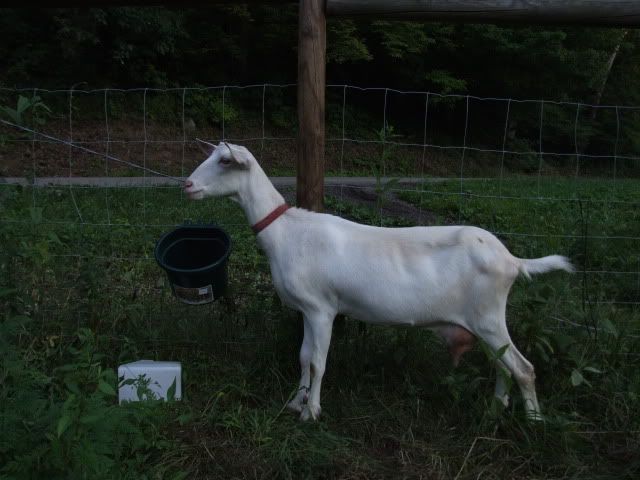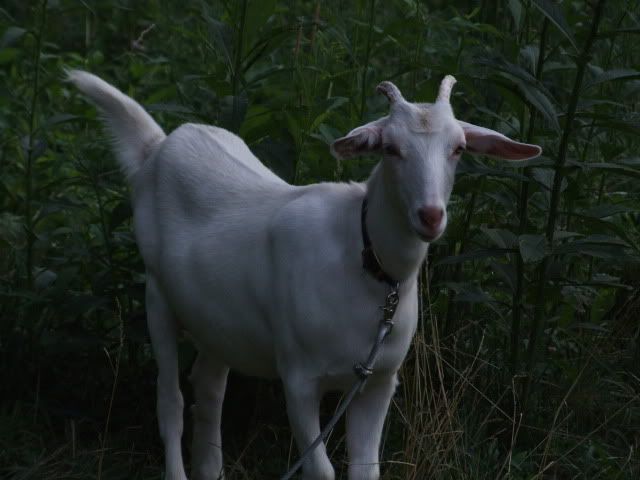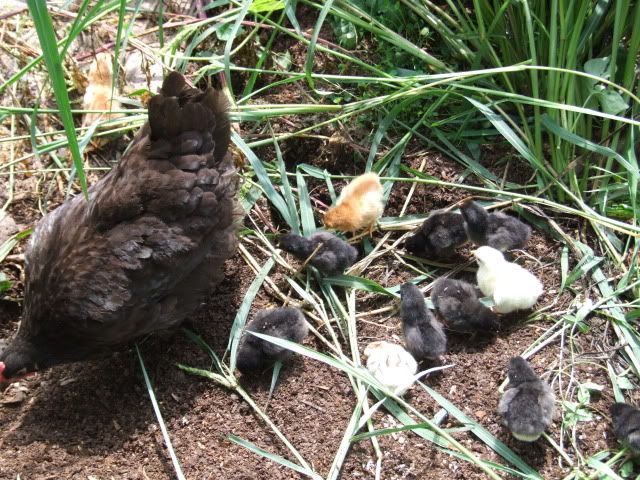We bought four started White Embden goslings. One has slipped wings and will be Christmas dinner. Of the remaining three, hopefully both genders are represented so that we can raise more goslings next year. They certainly keep the grass mowed down well!
The female Pekin duck with leg problems has recovered. I'm contemplating hatching a few ducklings next spring, since I have so many broody hens. The final remaining runner duck disappeared. I really liked the runner ducks, but they seem to be entirely too fragile for our farm.
Speaking of fragile, we're getting out of meat goats. All of the kids born this year died. I think it was stomach worms, even though we dewormed them, because with the new baby we weren't able to rotate them through the forest so they were just in the main pasture for most of the summer. There are two does left (because we sold three troublemakers earlier in the summer), and I need to get pictures of them and list them for sale.
However! In July we bought two Saanen does, with one of them in milk. She's dried off now, because she was producing so little, but during the summer we were getting nearly a gallon a day. The younger one is looking very round, so I'm beginning to wonder if she was bred before we bought her. It's not ideal to have young kids in autumn (although better than the depths of winter!), but if it turns out to be the case it will be nice to have milk through the winter. I still need to find a buck, preferably Saanen but other dairy is acceptable, to breed the other doe this winter. We're going to be focusing on dairy goats, with meat simply as a side product.


There are a bunch of new chicks. The two broody hens I wrote about before hatched out 14 chicks between them, and we also bought 50 Rhode Island Red pullet chicks from the hatchery. There was still one more broody hen last month, so I let her sit on another dozen eggs. She only hatched four, but is otherwise a good mother. One of the chicks has blue feathers and looks like it will be gorgeous. I'm hoping it's a pullet, but even if it's a cockerel I might still keep it. At this point there aren't any more broodies, which is good because the weather has gotten cold.

We have boarders at our farm. An acquaintance needed space for her animals, so in exchange for lumber and supplies to build shelters, we now have two sheep and a whole bunch of pygmy goats living in our pasture. She also brought her two rabbits and their hutches, but decided to give them to Cerra after Cerra said how much she loved them. So now we have rabbits. I believe that they are male and female, so we'll see about breeding some bunnies here soon. We'll want another hutch first, though, to house the young rabbits while they grow.
I've still got lots of work to do to get ready for winter. I've gotten a good start on the chicken shelter; I can probably finish it in a couple of hours at this point. I've started a shelter for hay for the goats. I'm pretty confidant in my ability to build the frame, but I'm a little bit anxious about the roof. I've never really built a roof before. The ducks and geese are set; they have our old truck shell for a shelter. We've gotten about seven years of use out of it, but it's finally gotten to the point where it's not safe to have on the truck anymore. I don't want the water fowl in with the chickens because they'll eat too much grain and get too fat. Finally, I haven't even started the run-in shed for the goats and sheep. I think I'll need to get the boarders to help me with that one in order to get it done reasonably soon. The weather was cold and wet for several weeks, and Paul was working at the post office, so that left me very little time to work on things at the farm. It's warm and dry now, so I need to take advantage of the weather and get things taken care of.
My garden didn't do all that well, what with the cool weather all summer. The corn was the only thing that really thrived. The tomato was planted much too late, but I was hoping to get at least a few fruits before winter. However, we had an extremely early first frost in September which killed the plant before any of the tomatoes were big enough to pick. The beans would have been great if they had been snap beans, but they're soup beans and I was growing them for seed. Only maybe half of the pods got mature enough to harvest before the weather got really cold. Oh, and the poor okra didn't tolerate the cool weather at all. The one month of hot weather in August got them growing well, but it had cooled off by the time they started setting fruit, and they all just rotted instead of developing.
When I get a chance, I'll post the egg tallies for the latest months and update the farm production in the sidebar.









































